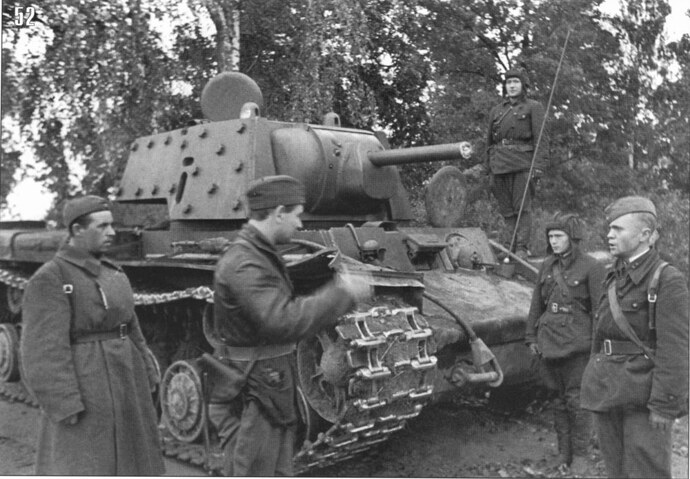KVs in action
While many crews were unexperienced with the new tank, some were able to make the German to pay a heavy price for their advance. Here they are some accounts:
Extracts from Thomas Jentz’s “Panzertruppen”, vol. 1 (posted on the Tanker’s Forum by Dr. Leo Niehorster)
6. Panzer-Division war diary, 25 June 41
"Unfortunately, the Russian 52 ton heavy tanks showed that it was almost insensitive to hits from the 10.5cm [field howitzer]. Several hits from a 15cm [field howitzer] were ineffective and bounced off. "
“… a Russian heavy tank had blocked the communications route … An 8.8cm Flak battery was sent up by the commander to fight this tank. It was just as unseccessful as the 10.5cm battery whose fire was directed by a forward observer. In addition, an attempt by a Pionier assault troop using balled explosives failed. It was impossible to get close to the tank because of heavy machine gun fire.”
3. Panzer-Division war diary, 10 Jan 42
“It is noteworthy that the Pz-III … hit a KV tank driving along the village street at a range of about 20 meters and four times at a range of 50 meters with 5cm Pzgr 40 without observing any effect.”
12. Panzer-Division war diary, 30 March 42
“… encountered a 52 ton tank and a T34. Under the covering fire from one Panzer, the other pair circled to the left and from a range of 50 to 80 meters opened fire on the enemy tanks. All three Pz-IV scored hits that showed no effect other than on the enemy morale… the 53 ton ton tank drove off at high speed … the T34 followed him.”
More than 30 hits in the side of this KV, the tank was probably destroyed for some 88mm.

The only way the Germans were able to achieve successes against the heavies in the early months was :
- by concentrating the fire of many tanks, in some cases an entire battalion (!) at ranges of 100 meters or less, which in many cases only caused damage.
- by maneouvering to the flanks and rear and opening fire at ranges of 50 meters or less, which in many cases again only caused immobilization.
- by coordinated fire on the tanks of all weapons, (which destroyed or separated the enemy infantry). Infantry and pioneers would then climb up on isolated or immobilzed enemy tanks and apply bundled stick grenades to less impervious areas, such as turret overhangs, etc.
- repeated non-damaging hits which caused the enemy crews to abandon their vehicles because of the noise and concussion.















